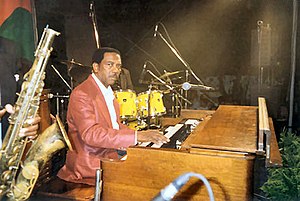This article needs additional citations for verification. (April 2024) |

An organ trio is a form of jazz ensemble consisting of three musicians; a Hammond organ player, a drummer, and either a jazz guitarist or a saxophone player. In some cases the saxophonist will join a trio which consists of an organist, guitarist, and drummer, making it a quartet.[1] Organ trios were a popular type of jazz ensemble for club and bar settings in the 1950s and 1960s, performing a blues-based style of jazz that incorporated elements of R&B.[2] The organ trio format was characterized by long improvised solos and an exploration of different musical "moods".[2]
In organ trios, the Hammond organist plays several roles, including playing the basslines (either on the bass pedalboard or on the lower manual of the organ), playing chords ("comping"), and playing lead melodic lines and solos. In organ trios with a guitarist, the guitarist usually 'fills in' the musical parts that the organist is not performing. For example, if the organist is soloing and playing a bassline, the guitarist may play chords.
Organ trios of the 1950s and 1960s often played soul jazz, a groove-infused style that incorporated blues, gospel and rhythm and blues. 1970s-era organ trios such as Tony Williams' band Lifetime played jazz-rock fusion. In the 1990s and 2000s, organ trios such as Medeski, Martin and Wood and Soulive became involved in the burgeoning jamband scene.
- ^ John F. Szwed (2000). Jazz 101:A Complete Guide to Learning and Loving Jazz. Hyperion. pp. 198–199. ISBN 0-7868-8496-7.
- ^ a b "Rick Zunigar - Guitarist". Archived from the original on 2007-04-03. Retrieved 15 April 2024.
